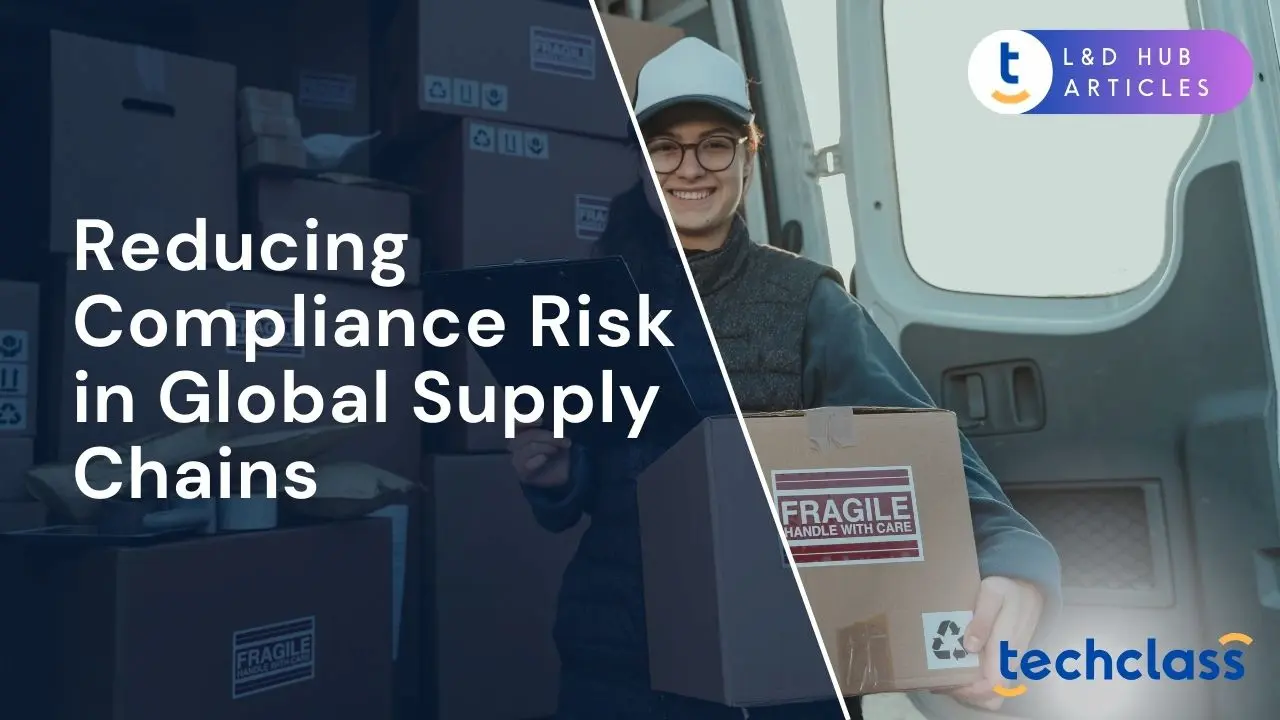The High Stakes of Supply Chain Compliance Risk
Global supply chains offer businesses immense opportunities for cost savings and market expansion, but they also expose companies to significant compliance risks. A single regulatory or ethical lapse by a supplier on the other side of the world can cascade into legal penalties, supply disruptions, and public scandal for the buying company. For example, the record-breaking €1.2 billion fine against Meta for data protection non-compliance underscores how costly regulatory failures can be in today’s environment. In the realm of physical supply chains, companies have faced shipments being seized or cancelled contracts due to violations like illegal sourcing or labor abuses. Nearly 38% of companies have identified parts of their supply chains at risk for forced or child labor, a sobering statistic that highlights the prevalence of compliance challenges.
Navigating this minefield requires a proactive and comprehensive approach. Supply chain compliance refers to ensuring that every link in the chain, from raw material suppliers to distributors, adheres to all relevant laws, regulations, and standards. This encompasses everything from customs and trade laws to labor standards, environmental regulations, and industry-specific safety requirements. When compliance failures occur, the costs are not just fines: organizations suffer reputational damage, operational disruptions, and loss of customer trust. In fact, one analysis estimates average non-compliance incidents cost organizations $14–40 million when considering all the direct and indirect fallout. Given these high stakes, reducing compliance risk in global supply chains has become an essential strategic priority for HR professionals, business owners, and enterprise leaders alike.
In this article, we explore the key compliance risks in global supply chains and practical strategies to mitigate them. The discussion is relevant across industries and is presented in an educational, professional tone to raise awareness at an early stage. By understanding the challenges and implementing best practices, organizations can protect themselves from legal troubles and reputational crises while fostering ethical, sustainable business growth.
Understanding Compliance Risk in Global Supply Chains
Compliance risk in a supply chain is the possibility that any part of that chain fails to meet legal or ethical standards, thereby putting the entire business at risk. Global supply chains magnify this risk because they span multiple countries, each with its own laws, regulations, and norms. Companies must ensure that products and processes comply with diverse regulatory requirements, from export/import laws and product safety standards to anti-corruption statutes and labor laws. For example, a business sourcing components internationally needs to adhere to customs rules and trade sanctions as well as verify that suppliers respect labor rights and environmental regulations. This broad scope means compliance risk touches many areas:
- Regulatory compliance: Meeting all applicable laws and trade regulations (customs duties, export controls, data protection laws, etc.).
- Ethical compliance: Upholding ethical standards such as fair labor practices, non-discrimination, health and safety, and environmental sustainability across suppliers.
- Industry-specific standards: Following standards unique to certain sectors (e.g. pharmaceutical traceability laws, food safety regulations, electronics hazardous substance restrictions).
What makes global supply chain compliance especially critical is the potential impact of failures. Non-compliance can lead to hefty fines, criminal penalties for executives, and the loss of licenses or market access. Regulators worldwide have ramped up enforcement: In the United States, the Uyghur Forced Labor Prevention Act (UFLPA)—effective since June 2022—presumes that goods made wholly or partly in China’s Xinjiang region involve forced labor, banning their import unless the importer can provide “clear and convincing evidence” to the contrary. In the European Union, the EU Deforestation Regulation (EUDR)—adopted in 2023 and applying from 30 December 2024—requires companies trading certain commodities (such as coffee, cocoa, soy, palm oil, timber, and cattle) to prove that their products are deforestation-free. In addition, the EU Regulation on Prohibiting Products Made with Forced Labour was formally agreed in 2024 and is expected to take effect after a transition period, establishing an EU-wide ban on products linked to forced labour. At the same time, consumers and investors are increasingly attuned to ethics, companies known to violate labor or environmental standards can face boycotts and reputational crises that harm their brand equity and sales. In positive terms, strong supply chain compliance offers benefits: it mitigates legal risks and prevents disruptions, protects brand reputation by demonstrating corporate responsibility, and supports financial stability by avoiding fines and costly delays. In short, understanding where compliance risks lie is the first step for organizations aiming to build resilience in their global operations.
Challenges in Ensuring Global Supply Chain Compliance
Maintaining compliance across a far-flung, multi-tiered supply chain is no simple task. Globalization and complexity introduce several challenges that enterprise leaders and compliance teams must contend with:
- Diverse legal frameworks: Each country in a supply chain may impose unique laws and standards. A multinational company might have to comply with dozens of regulatory regimes simultaneously. Keeping pace with varying product regulations, employment laws, environmental rules, and trade sanctions around the world is daunting. As one report notes, globalization introduces diverse regulatory environments, and international operations must navigate all these requirements, failing to do so risks penalties or shipment disruptions. The regulatory landscape is also a moving target; laws can change rapidly, requiring constant monitoring and updates to compliance processes. In recent years, for example, data privacy and ESG (environmental, social, governance) regulations have evolved quickly, forcing companies to adapt on the fly.
- Limited visibility into lower-tier suppliers: Large companies often have hundreds or thousands of suppliers, including subcontractors and sub-subcontractors several tiers down. Gaining transparency beyond the first tier is difficult. A firm might ensure its direct supplier is certified and compliant, only to later discover that the supplier’s own upstream provider was engaging in unlawful practices. Supply chain visibility remains a significant challenge, without end-to-end transparency, it’s hard to monitor compliance at every stage. This was evident in cases where brands were surprised by labor abuses or safety problems deep in their supply network. The complexity of modern supply chains (including third, fourth, or “n-th” party vendors) increases the risk that some link in the chain is non-compliant without the buyer’s knowledge.
- Keeping up with evolving regulations: International trade and compliance rules are not static. Geopolitical shifts, new legislation, and stricter standards mean that compliance today is a moving target. Compliance teams must stay current on sanctions lists, import/export classifications, anti-bribery laws, and more. One of the most formidable challenges is simply keeping up with all the country-specific sanctions and regulatory changes being issued, the speed and scope of these changes are dizzying. For instance, new laws targeting supply chain sustainability or cybersecurity can emerge and quickly gain enforcement teeth. Companies need mechanisms to continuously track regulatory updates across all regions they operate in.
- Resource and cost constraints: Achieving comprehensive compliance can require substantial investment in personnel, tools, and processes. Smaller enterprises or those with tight budgets may struggle to allocate enough resources for robust compliance management. Hiring compliance experts, conducting audits, and implementing new systems all carry costs. Additionally, there can be tension between business efficiency vs. compliance, ensuring every procedure is compliant might slow down operations or increase costs, which can be a hard sell internally. However, the cost of non-compliance (in fines, recalls, and brand damage) often far outweighs the cost of prevention. Leaders must balance these considerations and foster a mindset that compliance is a worthwhile investment.
In summary, global supply chain compliance efforts face headwinds due to regulatory complexity, lack of visibility, changing laws, and resource limitations. Recognizing these challenges helps organizations anticipate where their weak points might be. It also underlines why a proactive, systematic approach is needed to reduce compliance risk rather than reacting after a violation has occurred.
Best Practices to Reduce Compliance Risk
While the challenges are significant, companies can take concrete steps to mitigate compliance risks in their supply chains. The following best practices and strategies have proven effective across industries:
- Establish a Robust Supplier Code of Conduct: Set clear expectations by developing a comprehensive supplier code of conduct that all vendors must agree to. This document should spell out standards on labor conditions (e.g. prohibiting forced or child labor, ensuring fair wages), environmental practices, quality control, and business ethics (anti-corruption, data security, etc.). Write the code in clear language (especially if suppliers operate in other languages) and update it regularly to reflect new regulations. A strong code of conduct becomes the foundation for holding suppliers accountable. Many companies also include compliance clauses in supplier contracts (for example, requiring adherence to specific laws or audit rights) to give the code legal weight. By formalizing these standards, businesses create a shared understanding of compliance requirements from the outset.
- Perform Thorough Due Diligence and Risk Assessments: Before onboarding new suppliers, and periodically for existing ones, conduct detailed risk assessments and due diligence. This means evaluating a supplier’s compliance history, financial stability, certifications, and any past legal or ethical issues. High-risk indicators might include operating in countries with weak enforcement or in industries prone to issues (like mining, which might have higher environmental or labor risks). According to experts, companies should identify weak links in the chain and work with suppliers to address them or find alternatives. Prioritize assessment of critical suppliers or those in high-risk regions. Engaging third-party audits or on-site inspections can provide an independent check. The goal is to catch potential compliance problems early, “trust, but verify” is the mantra. Regular risk assessments (e.g. annually) help pinpoint where new vulnerabilities may be emerging so that you can act before a small issue becomes a crisis.
- Maintain Comprehensive Documentation and Records: Good record-keeping is both a regulatory requirement and a practical tool for compliance management. Document everything, from bills of materials and certificates of origin to safety test reports and training records. Proper documentation ensures that all transactions and processes can be checked against legal standards. For instance, keeping records of a product’s components and their source can verify that no sanctioned materials or conflict minerals were used. Store these records securely and organize them for easy retrieval during audits or inspections. Gaps or inconsistencies in documentation often hint at compliance issues (e.g. missing permits or unclear supply origins). By enforcing rigorous documentation from your suppliers and internally, you create a paper trail that can demonstrate due diligence. Many companies now use digital platforms to collect and manage supplier documents, which can automate reminders for updates (such as renewed certificates) and flag omissions.
- Enhance Supply Chain Transparency and Traceability: Lack of visibility can be fatal to compliance. Companies should strive to map their supply chain, know who your suppliers are, and who their suppliers are, as far back as reasonably possible. This might involve creating a database of supplier locations, ownership, and key practices. Some organizations use technology like blockchain, QR code tracking, or traceability software to follow products through each stage of the supply chain. Enhanced transparency can reveal hidden risks, such as a third-tier supplier in a region with known human rights issues. Additionally, encourage openness: establish channels for suppliers to communicate issues or for whistleblowers to report violations anonymously. When every participant knows that the supply network is monitored end-to-end, there is a stronger incentive for compliant behavior. Transparency not only aids in catching problems early, but it also builds trust with customers and regulators by showing the company has nothing to hide.
- Conduct Regular Audits and Monitoring: Auditing suppliers on a regular schedule is crucial to ensure ongoing compliance. This can include on-site inspections of factories, third-party social compliance audits (common in industries like apparel or electronics), and surprise spot-checks. Internal audits within the company’s own operations (procurement, logistics, etc.) are also valuable to ensure internal controls are effective. Both internal and external audits serve to identify issues early and provide an unbiased evaluation of compliance practices. Use a risk-based approach: audit higher-risk suppliers more frequently, and dig deeper on known areas of concern. In between formal audits, continuous monitoring is ideal, for example, using software that alerts you if a supplier’s certification expires or if they are mentioned in negative news. Some organizations subscribe to databases that flag if a supplier or its owners are added to denied-party or sanctions lists. With today’s tools, companies can receive real-time alerts on regulatory changes or supplier status changes, enabling a quick response. Automation can greatly assist here: given the complexity and speed of global trade rules, automated compliance software helps companies stay updated and flag non-compliance before it escalates.
- Provide Training and Education for Stakeholders: A company’s compliance efforts are only as strong as the people implementing them. Educate both employees and suppliers about compliance expectations. Internally, ensure your procurement teams, logistics staff, and relevant managers know the basics of trade regulations, anti-bribery laws, data privacy, etc., that apply to their work. Everyone involved in supply chain decisions should understand concepts like sanctions, denied parties, and embargoes in order to avoid violations. Regular training sessions (online modules, workshops, refresher courses) keep staff up to date on new rules and reinforce the importance of following procedures. For suppliers, consider onboarding training and periodic seminars or guidance documents on key compliance topics. As one expert notes, showing suppliers why compliance matters and sharing real-world examples can improve engagement and prevent costly mistakes. When both your internal team and external partners are knowledgeable, the overall compliance posture of the supply chain strengthens. Training also helps build a culture where people are proactive about raising concerns rather than looking the other way.
- Establish a Dedicated Compliance Function or Team: Particularly in larger enterprises, it pays to have a team (or individual) responsible for supply chain compliance governance. This compliance function should be well-resourced and have a clear mandate to oversee and update the compliance program. Their duties include tracking regulatory changes (often by consulting legal experts or industry groups), conducting risk assessments, and coordinating audits. They also serve as a focal point for handling any red flags that arise, such as investigating allegations of supplier misconduct. Importantly, a compliance team helps foster a culture of compliance across the organization. They can regularly report to leadership on the company’s compliance status, ensuring that executives and board members are aware of both risks and progress. For smaller companies that might not afford a full team, assigning a compliance champion or outsourcing certain compliance monitoring tasks can fill the gap. The key is to not leave compliance oversight as an ad-hoc responsibility, it needs ownership and expertise behind it.
- Develop Remediation and Contingency Plans: Even with robust precautions, issues may occasionally slip through. What distinguishes leading companies is how they respond. Create a corrective action plan template for supply chain issues. If a violation is found, say an audit discovers underage labor at a supplier, the plan should outline specific steps: e.g. immediately cease orders from that site, work with the supplier on remediation (or terminate the relationship if egregious), report the issue to authorities if required, compensate affected workers, etc. Having a clear protocol ensures a swift and effective response to any non-compliance incident. Additionally, think about contingency plans: if a key supplier is shut down due to compliance issues, do you have alternate suppliers ready or safety stock to prevent disruption? Planning for these scenarios reduces the shock if they occur. A well-handled remediation can mitigate risk and demonstrate the company’s commitment to ethical practices, whereas a slow or negligent response can exacerbate legal and reputational damage.
- Leverage Technology for Compliance Management: In an era of complex global operations, technology is an indispensable ally for reducing compliance risk. Compliance management software and supply chain risk platforms can automate many tasks, tracking regulatory updates across countries, managing supplier certifications, and even performing continuous risk scoring of vendors. For example, some companies use platforms that automatically cross-check supplier names against sanction lists or verify certificate authenticity. Blockchain and other traceability solutions, as mentioned, help maintain an incorruptible record of product provenance. Even simple data analytics can identify anomalies (such as a supplier suddenly changing its sourcing origin) that merit investigation. By investing in the right tools, organizations can stay one step ahead of compliance issues and handle the scale of global operations more efficiently. However, it’s worth noting that technology is only as effective as the data put into it, it should complement, not replace, the human judgment and ethical oversight needed for nuanced compliance decisions.
Implementing these best practices creates multiple lines of defense against compliance failures. Companies that integrate these strategies not only reduce the likelihood of violations, but also build more resilient and sustainable supply chains. Each of these measures, from strong codes of conduct to cutting-edge monitoring tools, contributes to a comprehensive compliance program. When combined, they greatly diminish the blind spots and weak links that often lead to compliance breakdowns.
Final Thoughts: Fostering a Culture of Compliance
Reducing compliance risk in global supply chains is not a one-time project, it’s an ongoing commitment that must be woven into the fabric of an organization’s culture. Ultimately, compliance is everyone’s responsibility. Enterprise leaders and HR professionals play a pivotal role in setting the tone from the top: when leadership prioritizes ethical conduct and regulatory adherence, that message cascades down to every employee and partner. By fostering a culture of compliance, companies encourage vigilance and accountability at all levels. Employees should feel empowered to speak up about potential issues, and suppliers should understand that doing the right thing is non-negotiable in the business relationship.
In practical terms, fostering this culture means continuously communicating the importance of compliance and celebrating those who proactively manage risks or improve standards. It means aligning incentives so that procurement or operations teams are rewarded not just for cost savings or speed, but also for maintaining high compliance and quality standards. When compliance is seen not as a burden but as a core value that protects the company and its stakeholders, organizations are far less likely to experience major breaches.
The global regulatory environment will only grow more stringent in the coming years, and supply chains will likely become even more complex with new technologies and market dynamics. Companies that treat compliance as a strategic priority, investing in their people, processes, and systems to uphold standards, will navigate these changes more smoothly. They will avoid the costly pitfalls that befall less prepared competitors and will earn trust from customers, regulators, and the public. In an interconnected world, supply chain integrity is a cornerstone of sustainable business success. By taking a proactive, culture-driven approach to compliance risk management, businesses can confidently pursue global opportunities knowing that their values and operations remain in alignment every step of the way.
FAQ
What is compliance risk in global supply chains?
Compliance risk refers to the potential for any part of a supply chain to violate legal, regulatory, or ethical standards. This can include breaches in labor laws, trade regulations, environmental rules, or industry-specific requirements, which can lead to fines, supply disruptions, and reputational damage.
Why is compliance important for global supply chains?
Compliance ensures that businesses meet all applicable legal and ethical requirements, reducing the likelihood of fines, shipment delays, and brand reputation damage. It also builds trust with customers, regulators, and stakeholders while fostering sustainable business practices.
What are the biggest challenges in maintaining supply chain compliance?
Key challenges include navigating diverse international regulations, limited visibility into lower-tier suppliers, rapidly changing laws, and resource constraints. These factors make it difficult to monitor every part of a global supply network effectively.
How can companies reduce compliance risk in their supply chains?
Best practices include creating a supplier code of conduct, performing regular audits, using technology for monitoring, conducting thorough supplier risk assessments, enhancing transparency, training stakeholders, and having remediation plans in place.
What role does technology play in supply chain compliance?
Technology helps track regulatory changes, monitor supplier performance, and enhance traceability. Tools like compliance management software, blockchain, and automated alerts can flag risks, verify certifications, and provide real-time visibility into supplier activities.
References
- Thomson Reuters Tax & Accounting. Managing supply chain issues and mitigating risk. Thomson Reuters blog; https://tax.thomsonreuters.com/blog/managing-supply-chain-issues-and-mitigating-risk/
- Hodges R. How to Improve Supply Chain Compliance – 8 Key Tactics for Businesses. Oritain Blog; https://oritain.com/resources/blog/improve-supply-chain-compliance-8-key-tactics-for-businesses
- Xiang L. Understanding Supply Chain Compliance: A Comprehensive Guide. JUSDA (Jusda Global) Insights; https://www.jusdaglobal.com/en/article/understanding-supply-chain-compliance-guide/
- Sarhan A, Li V. Key takeaways from the 2024 Annual Report on forced labour and child labour in supply chains. DLA Piper Insights; https://www.dlapiper.com/en/insights/publications/2024/10/key-takeaways-from-the-2024-annual-report-on-forced-labour-and-child-labour-in-supply-chains
- Goldman D. Ensuring Global Supply Chain Compliance Across Regulations. Panorays Blog;
https://panorays.com/blog/global-supply-chain-compliance-multiple-regulations/
- Trinh T. The Hidden Price Tag: Understanding the Full Cost of Regulatory Non-Compliance. VisiumKMS Whitepaper; https://www.visiumkms.com/blog/the-hidden-price-tag-understanding-the-full-cost-of-regulatory-non-compliance/
Weekly Learning Highlights
Get the latest articles, expert tips, and exclusive updates in your inbox every week. No spam, just valuable learning and development resources.



